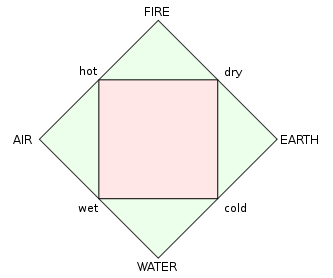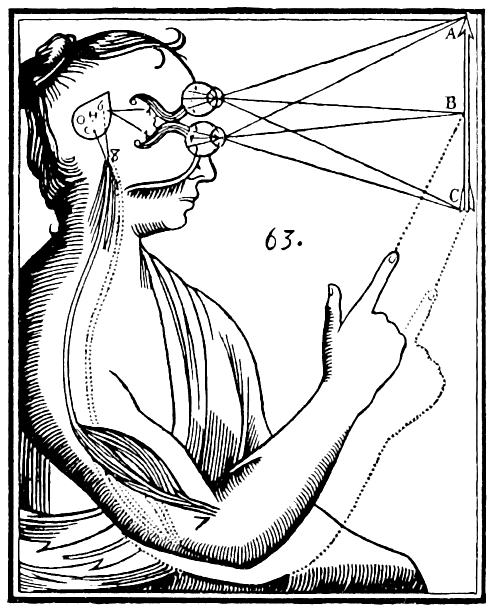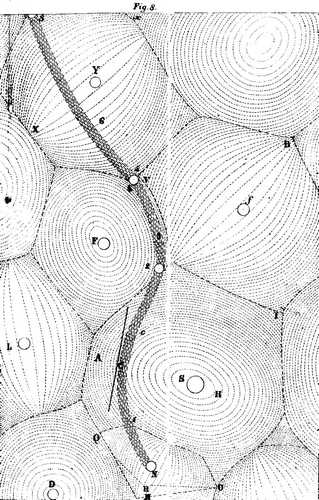Mechanical Philosophy
by Andrew Boyd
Today, things that go bump. The University of Houston presents this series about the machines that make our civilization run, and the people whose ingenuity created them.
In the 1996 comedy Happy Gilmore, comedian Kevin Nealon explains to Adam Sandler the metaphysics of golf.
The very idea of a golf ball being drawn to its "natural environment" seems nothing short of crazy. For much of history, however, this is exactly how natural philosophers explained the world.

A golf ball directly before the hole. Photo Credit: Wikimedia Commons
The classical Greek elements earth, air, fire, and water were long used to explain the way things moved. Fire lacked weight and would lift objects to the heavens. Earth was heavy, and would pull them to the ground. Every object was thought to be some mix of these four basic elements, which in turn governed how it moved.

The four classical elements, after Aristotle. Photo Credit: Wikimedia Commons
Silly as this sounds, it had the potential for being a viable theory if the Greeks had made an effort to better define what the four elements were. Instead, their logic was circular. A rock falls to the ground because it contains so much earth. And what is earth? It's that which makes a rock fall to the ground.
This kind of thinking rankled natural philosophers of the seventeenth century. Addressing a related theory, Descartes' wrote, "[The theory was] introduced by philosophers to account for 'the action of natural things.' But no natural action at all can be explained by [them], since [as] their defenders admit they are occult."
Descartes' and his contemporaries were busy with new theories that tossed out the occult properties of objects and replaced them with a universe of objects bumping into one another. Heat could be explained by the rapid movement of small objects called "atoms"; sight was light striking the eyes. This new way of looking at the world came to be known as mechanical philosophy.

Drawing from Ren' Descartes' (1596-1650) in "Treatise of Man" explaining the function of the pineal gland. Photo Credit: Wikimedia Commons
Champions of mechanical philosophy saw their activities as more than simply putting forward a new theory. They saw themselves as slayers of ignorance. And in actuality they were. But dogmatism in any form can lead to trouble.
Which is what happened when Sir Isaac Newton proposed his theory of gravity. Gravity, it seemed, wasn't the result of matter colliding with matter. It was a property of matter, leaving it open to accusations of being occult.
The answer? Describe gravity in terms of objects bumping into other objects so that Newton's gravity and mechanical philosophy could peacefully coexist. This required filling space with an as yet unseen aether ' a physical substance that would make gravity work. No such aether was ever found, and aether theories were eventually abandoned, though their demise took centuries.

Aether vortex around suns and planets. Photo Credit: Wikimedia Commons
Still, while mechanical philosophers weren't always right, they helped set us on the right course by freeing us from objects in search of their "natural home."
Heh, heh. Send him home. I'll just send him home. Time to go home there, ball.
I'm Andy Boyd at the University of Houston, where we're interested in the way inventive minds work.
(Theme music)
T. McGrew. The Theory of the Elements. From the Western Michigan University website: http://homepages.wmich.edu/~mcgrew/elements.htm. Accessed August 1, 2015.
The Strategy of Cartesian Physics. From the Descartes' Physics entry of the website of the Stanford Encyclopedia of Philosophy: http://plato.stanford.edu/entries/descartes-physics/#2. Accessed August 1, 2015.
Substantial Form. From the Wikipedia website: https://en.wikipedia.org/wiki/Substantial_form. Accessed August 1, 2015.
This episode was first aired on August 13, 2015